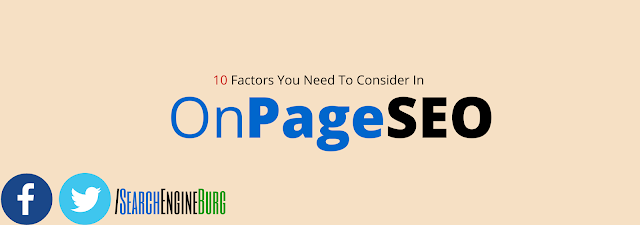Could be yes or may not, depending on the type of blog. In developing SearchEngineBurg, I pay attention to SEO, both on-page SEO and off-page SEO (link building).
Based on my experience optimizing blogs niche in English with the results of entrance Google.com page 1, there are ten factors on-page SEO that you should take to note.
1. Keywords in the Title
The first and most important on-page SEO is to place the targeted keywords in the title.These keywords provide an overview to the search engines about the content of the blog or post.According to Moz, the long title amounted to 55 characters (words and spaces).Keywords that are placed in the post title will be automatically in the post title. However,not so with the keyword for the title of the blog.If you're using WordPress,you can place keywords in the title of the blog by using the plugin All in One SEO Pack or Yoast's WordPress SEO.
Where the keywords should be placed on the title? If possible, place your keywords in the beginning of your title to be easily recognized by potential visitors and search engines. When laying the keywords in the beginning of the title is not possible, for example, make the title becomes debatable, place keywords in the title naturally.
2. Density Keyword
The next factor of on-page SEO is keyword density.The definition of keyword density is the percentage of the keyword to the number of words.In order not indicated deploy redundant keyword (keywod stuffing),you should create a keyword density of between 1% to 5%.For example,your target keywords job application letter. The keyword appears five times in a 500 word posts you make. Thus,the density of a job application letter at the post is 1% or 5 divided by 500.
3. Keywords in the first Paragraph and the Last
Besides the title, the targeted keywords should be placed well in the first paragraph and the last paragraph.In my opinion,this placement provides an overview of topics beginning and end of the search engine.
4. Number of Words
In conducting on-page SEO, you should also pay attention to the word count. According to some studies,the number of words have an important effect on the position in the search results of search engines.The trick, if aiming for high competition keywords, you should make a post with a minimum length of 1,500 words.Viewed from the human side and the search engines, the number of the word is enough to give more detailed explanations of keywords or topics covered.In other words, your post is rich in meaning or benefit.
5. Format Heading
Format heading (H2, H3, and so on) can also be used to optimize the structure of your posts. Which format to choose? I think it depends on the tastes of the blogger.For me,the format H3 is enough to explain the points-pound or subtitle postings are made.
6. Alt Text
The search engine can detect images through alternative text for images (alt text).For this purpose,create alternative text as possible.Some SEO practitioners suggest this alternative text is filled with the targeted keywords.However,I ignored this advice because I filled the alternative text with keywords associated with the targeted keywords.
7. Internal Link
Do not forget to include a link to your previous post (known as internal link).In addition to providing post linkage signal to the search engines, internal links also provide additional information to visitors.
8. External Link
In addition to external links,create also a link to a blog or other trusted person website (external link).The goal gave the signal to the search engines that your postings referring to the source or a reliable reference. Of course,external links also provide an additional option references to visitors who want to know more about the topic of your post.
9. Latent Semantic Indexing
Do not just show the keywords in your posts.Instead, show also the keywords that are relevant to the targeted keywords.The relevance of including latent semantic indexing (LSI).For the purpose of this LSI,I usually use a synonym or a fragment of the targeted keywords.For example,top-rated vacuum cleaners are synonyms best vacuum cleaners.The use of LSI aims to give a signal to the search engines that your postings naturally as promoting the context,not the text.I believe Google knows these signals because the algorithm is made to understand the context of the content.
10. Speed Loading Blog
The last factor is the speed of loading your blog.This factor is important because it affects the experience of visitors to your blog and Google include it as one of the factors in the ranking of search results.Of course,the speed of loading your blog affected the quality of hosting used.
From The Author!
- On-Page Factors (Moz)
- On-Page SEO: Anatomy of a Perfectly Optimized Page (Baclinko)
- SEO 101: Getting The Basics On-Page SEO (Search Engine Journal)












Yet another great post Abdullah. Keep up the good work. :)
ReplyDeleteThanks, Amir! I’ll definitely keep bringing the noise 😀
DeleteYeah..Thanks for your valuable words,I really appreciate it.
Delete